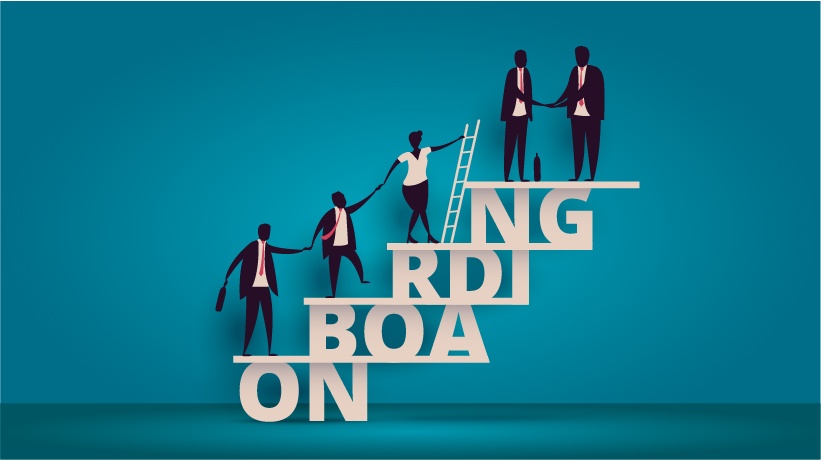What You Should Be Aware Of When Designing An Employee Onboarding Program
Your onboarding program leaves a lasting impression. Employees decided whether to stay with an organization within the first couple of months. 20% of new hires leave for new opportunities within the first 45 days [1]. This makes the new hire experience, and the onboarding process, an important factor in raising employee retention rates. Employees who have been properly onboarded have also been proven to become productive more quickly. In a recent survey, it was found that more than half of organizations that implemented a formal onboarding process experienced an increase in both productivity and new hire retention [2].
What about the other half? Simply having an onboarding program is not enough. In a recent study surveying over 400 companies, it was reported that only 40% felt their onboarding programs were effective.
The Most Successful Onboarding Programs Focus On The New Hire Experience By Following These 10 Do’s And Don’ts
1. Do Plan Pre-Boarding Activities
Pre-boarding is when you take some of the traditional onboarding activities and start them between when they sign their offer letter and their first day. This helps new hires in a couple of ways. There is a lot to take in when starting a new job. Pre-boarding spaces out the flow of information so new hires don’t become overwhelmed during their first day. Preboarding activities also boost confidence by giving new employees a chance to prepare for their first day. This is probably why companies who include pre-boarding as part of their onboarding process retain 81% of their new hires in the first year [2].
Some common pre-boarding activities include:
- HR and tax paperwork
Most paperwork can be filled out and signed digitally. E-mailing this in advance saves both the employee and employer time. - Employee handbook
Sending an employee handbook or pamphlet ahead of time enables them to prepare for what their workplace culture, policies and procedures will be like. - Onboarding checklist
Sending out a checklist ahead of time lets new hires know what to expect.
2. Don’t Focus Solely On Paperwork
58% of organizations say their onboarding program is mostly focused on processes and paperwork [5]. Although HR paperwork and tax information are an important part of the new hire process it should not be the bulk of your onboarding program. Most paperwork can be filled out in advance, making time for other important activities, like training and socialization. In a recent study, more than half of the employees that participate rated training as their top priority in the first week of starting a new position [6].
3. Do Design An Onboarding Program That Lasts For 90 Days Or More
Onboarding programs are supposed to support new employees and teach them the skills they need to be successful in their new workplace. On average, it takes a new employee 8 months to become fully proficient and productive at work [4]. Most onboarding programs last no longer than the first 3 months [4]. This is means that most employees go 5 months without the support they need.
New hires that provide longer onboarding experiences become proficient more than 30% faster than those who don’t [4]. The most successful programs last an entire year and have frequent check-ins to ensure new employees are on track.
4. Don’t Forget To Schedule Check-Ins Before A New Hire’s Start Date
Ghosting is becoming more and more common. Many companies have reported increased cases of interview no shows, new employees who suddenly stop showing up, and new hires who never show up for their first day. Many businesses have reported that up to 50% of applicants and new hires are ghosting them sometime between interviewing and the first few weeks on the job [3].
A lot can happen in the time between accepting a new job and the actual start day. Employees might receive other offers, simply change their minds, or their previous employers may offer them a promotion.
The best way to decrease the number of no shows is to plan check-ins when designing an onboarding program. You want to avoid long periods of time with no contact. This can be done by sending a welcome e-mail or a phone call before their first day to see if they have any new questions or concerns.
Checking in lets new employees know you haven’t forgotten about them and that you are excited for them to be a part of your team.
5. Do Create An Onboarding Plan/Checklist To Share With New Employees
Having a structured plan or checklist has benefits for both new employees and their supervisors. New employees can see what is expected of them. This empowers them to prepare and work towards accomplishing goals. Supervisors can track the progress of their employees and see what they have done or what still needs to be completed. Checklists help keep everyone on the same page and ensure that each stage of the onboarding is completed.
6. Don’t Overwhelm New Hires
There is much to learn about a company when you first start. Some things are job or role-specific, some are company culture-related, and others are about the organization, like company-specific policies. Each is important, but there is no way a new hire can absorb all this in the first day or even in the first week. Most employees take almost a year to adjust and reach full productivity.
This is why it is important to structure your onboarding program in a way that provides employees with the most important information first and give the rest in relevant digestible chunks. This way employees retain the information you give them and reach proficiency more quickly.
7. Do Plan For Social Integration
One of the most underrated components of an onboarding program is social integration. Positive work relationships increase productivity and employee satisfaction.
70% of employees said that having friends at work is one of the most important factors in a happy work life. More than half of men and women said they would turn down a high paying job if they didn’t get along with their co-workers [7].
8. Don’t Leave Onboarding To HR Alone
Many companies make the mistake of leaving the onboarding process entirely to HR, but it takes team involvement to create a successful onboarding program. Managers and teammates are important because they have insights into job specifics that HR professionals may not.
When designing an onboarding program remember to utilize social and team building activities, like mentoring. New employees benefit from making connections with their peers. If the onboarding program only involves HR it is less likely they will connect with their teammates or become familiar with the company culture.
9. Do Plan Regular Check-Ins
Most onboarding plans involve check-ins with a manager or mentor in the first week or two. This is a great start, but the best onboarding programs provide check-ins throughout the first year. Having one on one time with a manager or mentor gives employees time to ask questions. It also gives managers a chance to make sure employees are on track and are meeting expectations.
10. Don’t Forget To Ask For Feedback
When designing an onboarding program make sure you plan to ask for feedback as the onboarding experience ends. This could come in the form of a survey or even just a conversation asking an employee about their thoughts on the process. It is important to ask what they liked, what they didn’t, and what they think could be better. These kinds of questions lead to insights you won’t get anywhere else and can help you improve your onboarding program. It also enhances the overall experience by letting employees know that you care about both the quality of their experience and their opinions.
Conclusion
Following these 10 do’s and don’ts will help you design a successful onboarding program focused on the new-hire experience. Potential employees are looking for opportunities to work with organizations that are going to invest in them. A great onboarding program shows new hires that you want them to be successful. Onboarding benefits both parties. Providing new hires with the training and support they need boosts ROI, increases engagement and speeds up the time to reach proficiency.
Discover all the best practices on transforming the new hires into productive members of your organization! Download the eBook The Definitive Guide To Onboarding Programs and manage to improve new hire retention rates, speed up the rate of competency and increase productivity.
References:
[1] Talent Pulse—Onboarding Outcomes: Fulfill New Hire Expectations
[2] Perfecting The Onboarding Funnel
[3] Workers are 'ghosting' interviews, blowing off work in a strong job market
[4] 10 Simple Ways To Improve Onboarding For Increased Retention
[5] 10 Employee Onboarding Statistics You Must Know In 2019
[6] Onboarding Key To Retaining, Engaging Talent
[7] [Infographic] The Onboarding New Hire Statistics You Need to Know (with 2018 Updates)









